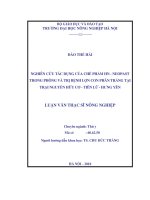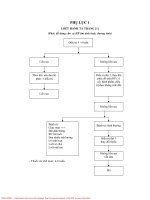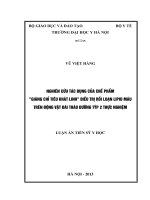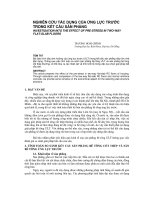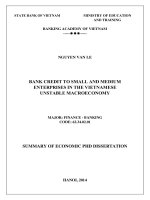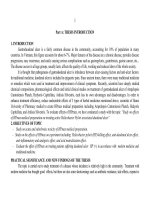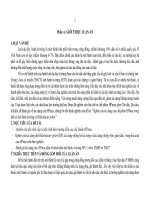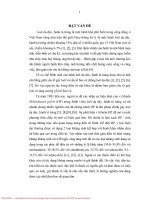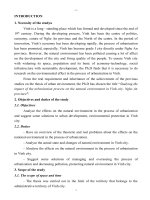nghiên cứu tác dụng của chế phẩm hpmax trong điều tri loét hành tá tràngcó helicobacter pylori bản tóm tắt tiếng anh
Bạn đang xem bản rút gọn của tài liệu. Xem và tải ngay bản đầy đủ của tài liệu tại đây (276.09 KB, 31 trang )
1
Part A: THESIS INTRODUCTION
1. INTRODUCTION
Gastroduodenal ulcer is a fairly common disease in the community, accounting for 10% of population in many
countries. In Vietnam, this figure accounts for about 6-7%. Major features of the disease are a chronic disease, periodic disease
progression, easy recurrence, and easily causing serious complications such as gastropyloric, gastrobrosis, gastric cancer, etc
The disease occurs in all age groups, usually lasts, affects the quality of life, working and reduces labor of the whole society.
It is thought that pathogenesis of gastroduodenal ulcer is imbalance between ulcer-causing factors and anti-ulcer factors.
In traditional medicine, duodenal ulcer is included in epigastric pain. Since ancient times, there were many traditional medicine
or remedies which were used in treatment and improvement of clinical symptoms. Recently, scientists have deeply studied
chemical compositions, pharmacological effects and initial clinical studies on treatment of gastroduodenal ulcer of Ampelopsis
Cantoniensis Planch, Hedyotis Capitellata, Ardisia Silvestris, each has its own advantages and disadvantages. In order to
enhance treatment efficiency, reduce undesirable effects of 3 types of herbal medicines mentioned above, scientists of Hanoi
University of Pharmacy studied to create HPmax medical preparation including Ampelopsis Cantoniensis Planch, Hedyotis
Capitellata, and Ardisia Silvestris. To evaluate effects of HPmax, we have conducted a study with the topic “Study on effects
of HPmax medical preparation on treating active Helicobacter Pylori associated duodenal ulcer”
2. OBJECTIVES OF TOPIC
- Study on acute and subchronic toxicity of HPmax medical preparation.
- Study on the effects of HPmax on experiment including Helicobacter pylori (HP)-killing effect, anti-duodenal ulcer effect,
anti-inflammatory and analgesic effect, and acid neutralization effect.
- Evaluate the effect of HPmax on treating patients suffering duodenal ulcer HP (+) in accordance with modern medicine and
traditional medicine.
PRACTICAL SIGNIFICANCE AND NEW FINDINGS OF THE THESIS
The topic is carried out to study treatment of a disease whose incidence is relatively high in the community. Treatment with
modern medicine has brought good effects, but there are also some shortcomings such as antibiotic resistance, side effects, expensive
price, etc Therefore, it is necessary to continue looking for new medicines derived from herbs which are effective, safe and
2
inexpensive. And this is also the research trend which scientists are very interested in.
The thesis has closely and sytematically studied both pre-clinical and clinical matters of a new traditional medicine
preparation which has the components including three Vietnamese herbs available in the community used for treatment of active
HP associated duodenal ulcer.
The research findings of thesis contribute to prove the real value of traditional medicine which is a product of oriental culture,
contributing to have positive influences on cultural traditions through use of traditional therapies, encourage ethnic pride, preserve national
cultural identity, and improve public health.
Study on application of traditional medicinal remedy in treatment contributes to clarify the theories of traditional medicine,
and modernization of traditional medicine step by step is a practical action with scientific meaning.
Structure of the thesis:
In addition to Introduction and Conclusion, the thesis has 4 chapters:
Chapter 1: Overview
Chapter 2: Materials and research methods page
Chapter 3: Research findings page
Chapter 4: Discussion page
The thesis has: 48 tables, 9 charts, 3 figures, 1 diagrams and appendices, 165 references (82 written by Vietnamse, 72 written by
English and 13 written by Chinese).
Part B: THESIS CONTENTS
CHAPTER 1: OVERVIEW
1.1. DEFINITION, PATHOGENESIS, DIAGNOSIS AND TREATMENT OF DUODENAL ULCER ACCORDING MODERN
MEDICINE POINT’S VIEW
* Definition
Gastroduodenal ulcer is defined as “lesions of mucous layer, through membrane layer to muscular layer”.
* Pathogenesis of gastroduodenal ulcer
3
Is due to the imbalance between ulcer-causing factors and anti-ulcer factors (protective factors)
+ Ulcer-causing factors: acid HCl, pepsin, Helicobacter pylori bacterium, nonsteroidal anti-inflammatory drugs, etc
+ Protective factors: mucin, vascular system of duodenal and gastric mucosa, alkaline salts, etc
* Treatment
Treatment methods include lifestyle adjustment and medicine use ; medicine use is in accordance with the regimens of
Vietnam Association of Gastroenterology (2012) : first regimen : PPI+ Amoxicilin+ Clarithromycin 7-14 days ; second regimen :
(after the first failure) use the 4-drug regimen with Bismuth if previously this treatment regimen has not been used yet, use the
regimen PPI + Amoxicilin + Levofloxacin if the 4-drug regimen with Bismuth was used previously ; do not reuse the antibiotics
used in the previously failed treatment regimen, especially Clarithromycin (except for Amoxicilin) because the ratio of secondary
drug resistance is very high; Salvage treatment regimen: If disease eradication still fails after two treatments, should grow
bacteria and perform antibiotic susceptibility testing to select appropriate antibiotics.
1.2. CAUSES, PATHOGENESIS, SYMPTOMS AND TREATMENT PRINCIPLES OF DUODENAL ULCER ACCORDING
TRADITIONAL MEDICINE’S POINT OF VIEW
In traditional medicine, duodenal ulcer is included in syndrome of epigastric pain.
Epigastric pain syndrome relates the diseases which have symptoms of pain in epigastrium under the xiphoid.
* Causes and pathogenesis of epigastric pain syndrome
+ Eating and drinking: Caused by unhealthy eating and drinking, irregularly hungry or surfeited state, or eating a
lot of raw, spicy, hot, sour, cold, and stale foods and beverages which hurts stomach, and causes pain.
+ Depressed sentiment and will: depressed sentiment and will make liver unhealthy, liver qui depression; digestive
function of stomach is lost, which causes pains, called as liver qi stagnated stomach (liver against spleen – liver depression and
stomach deficiency).
+ Weak physical condition (spleen stomach deficiency): Weak physical condition, irregular eating and drinking habits,
excessive labor for a long time make spleen and stomach unrested, which leads to spleen stomach deficiency, and causes dull
ache, etc
* Treatment according problem classification : Epigastric pain syndrome is divided into two major types.
+ Sstagnated liver qi affected to stomach
4
-Symptoms:Epigastric pain, pain spreading to chest side, belching, heartburn, and defecation with raw shit, irritability,
more anger more pain, pale tongue coating, pink tongue, stretched vessel.
- Treatment method: Liver and stomach harmony, “circulating qi and stopping pain”
- Medicine: “chai hu shu gan tang” or “xiao yao san”.
+ Deficient and cold spleen and stomach
- Symptoms: Dull ache in epigastrium, colder sorer; patients like massage and fomentation when sore; like warm and hot
food; defecation with watery shit, slippery white tongue coating, flabby tongue; vessels are deep under the skin.
- Treatment method: “Warming central body pat and strenthening spleen”, “Harmonizing stomach and stopping pain”
- Medicine: “Huang qi jian zhong tang”
1.3 Studied medicine:
Components of HPmax medical preparation include Ampelopsis Cantoniensis Planch 280mg, Hedyotis Capitellata 170mg,
and Ardisia Silvestris 110mg.
Based on independent researches of each herb, we find that Ampelopsis Cantoniensis Planch, Hedyotis Capitellata,
Ardisia Silvestris have both experimental and clinical effects such as anti-inflammatory, analgesic, acid neutralization, anti-
gastric ulcer, healing of gastroduodenal ulcer. Each of them has its own advantages and disadvantages. Therefore, traditional
pharmacists combined three herbs mentioned above in HPmax medical preparation with the hope that it will bring better
therapeutic effect than individual use of each herb. However, whether this combination ensures to only create positive
interaction without adverse interactions or not? This study will contribute to answering these questions.
CHAPTER 2: MATERIALS AND RESEARCH METHODS
2.1. RESEARCH MATERIALS
2.1.1. Drugs used for experimental study
- HPmax capsule manufactured by VINACOM natural products Joint Stock Company on modern production line
conforming to GMP standards and basic standards with certificate issued by Examination Center under Hanoi Department of Health.
- Syndrome group drugs: Ranitidin, Aspegic, Prednisolon…
5
2.1.2. Drugs on clinical study
- Research group (group 1) uses HPmax medical preparation
- Syndrome group (group 2) uses Omeprazol + Amoxicilin+ Clarithromycin
2.2. RESEARCH OBJECTS
Experimental animals : 190 Swiss white rats, weight 20 ± 2g; 144 Wistar white rats, healthy, both genders, average
weight 140-180g; 30 mature Oryctolagus Curiculus rabbits, both genders, weight 1.8-2.0 kg.
Helicobacter pylori inoculation is subdivided from biopsy of patient’s stomach.
2.2.2. Clinical study
85 patients of both genders have been diagnosed as active HP associated duodenal ulcer. Patients have been treated at
Army Central Hospital 108 and Traditional Medicine Hospital- Ministry of Public Security.
* Criteria to select research patients:
* Clinical: Epigastric pain, eructation, heartburn, vomiting, nausea, bloating, constipation, poor eating and sleeping.
Not taking any drugs to treat gastroduodenal ulcer, or stop trating with other drugs at least 2 months before research.
* Nonclinical:
- Patient is diagnosed with duodenal ulcer through fiber endoscope, ulcer with dimension > 5 mm.
- Diagnose Helicobacter pylori (+) by both methods of test Urease and pathologic histology.
* Selection based on traditional medicine: two types including stagnated liver qi affected to stomach; deficient and
cold spleen stomach .
* Criteria to exclude patients out of research :
- HP (-) negative by one of two methods : Test Urease and pathologic histology.
- Pregnant woman and breastfeeding mothers.
- Patients who suffer from stomach ulcer and cancer with complication due to ulcer such as: hole, bleeding, etc.
- Patients who are taking other drugs for duodenal ulcer.
- Patients who do not follow treatment process (stop taking drugs for more than 3 days, not doing endoscope after
treatment)
2.3. RESEARCH METHODS
6
2.3.1. Experimental research
* Acute and subchronic toxicity research
- Acute toxicity : identified on white mice orally as instructed by Ministry of Health and World Health Organization, Seven
groups of white mice, 10 for each group, taking reagent at the highest dose without any death to the rats to the lowest with 100%
death to the rats, constant volume for each time is 0.3ml/10g weight, taking 3 times/24 hours, 2 hours from the last to the next
time.
Observe general conditions of rats and number of dead rats for each group for 72 hours (rats dying for the first 2 hours
shall be operated to observe general conditions). Continue observing conditions of rats until the 7th day after taking reagent.
Calculate LD
50
by Litchfield- Wilcoxon method.
- Subchronic toxicity test: experiment on rabbits at dose of 0.202g/kg (equivalent to on human with indicator 3) and and
dose of 1.010g/kg/day (5 times more than dose of group 1). The rabbits have drunk water or reagent for 4 continuous weeks,
one time per day in the mornings. After 4 weeks, the rabbits stop taking drugs and are under observation to evaluate recovery
(in case reagent has any toxicity) or slow toxicity of the drugs.
Observe weight, eating, sleeping, activities, digestion, hematology, biochemistry, liver, kidney at the time beforr taking drugs,
2-4 weeks after taking drugs and 2 weeks after stopping taking drugs. Observe general conditions, pathologic histology of liver and
kidney 4 weeks after stopping taking drugs and 2 weeks after stopping taking drugs.
* Experimental anti-duodenal ulcer effect research
- Study on Anti-duodenal uncer effect with ulcer induced by cysteamin: 64 rats divided into 4 groups: group 1 (n=10) is
group of distilled water rats without ulcer induced by taking cysteamin ; group 2 (n=18) is group of distilled water rats with ulcer
induced by taking cysteamin ; group 3 (n=18) is group of rats taking standard drugs, Ranitidin 50mg/kg before inducing ulcer by
taking cysteamin ; group 4 (n=18) is research group with rats taking HPmax at dose of 470mg/kg before inducing ulcer by taking
cysteamin. Compare average ulcer indicator of each group to evaluate findings.
- Study on effect of disabling HP in vitro : Evaluate influence of HPmax on HP implemented by direct bacterial inhibition
method, in specific environment.
- Study on Anti-inflammation effect
+ Study on Anti-inflammation effect by swelling rats’ legs with carragenin:
7
White rats are divided into 4 groups, 10 for each group. Group 1 drinks distilled water, group 2 drinks aspégic at dose
of 200 mg/kg/day; group 3 takes HPmax at dose of 560mg/kg /day; group 4 takes HPmax at dose of 1120/kg /day. The
rats have drunk water or drugs for 5 continuous days before inducing ulcer. On the 5
th
day, after taking drugs for 1 hour,
induce ulcer by carragenin 1% (mixed in physiological saline) 0.05ml/rat injected subcutaneously of sole of the back
right leg. Measure volume of leg (to ankle) by special equipment and compare all groups.
+ Study on Anti-inflammation effect by inducing peritoneal effusion
The rats are divided into groups and take drugs as mentioned above. On the 5
th
day, after taking drugs for 1 hour, induce
peritonitis by solutions including: 0.05g carragenin, 1.4 ml formaldehyd mixed in 100ml adequate physiological saline. Inject
into peritoneal cavity with the above solution at volume 2ml for each rat. 24 hours after inducing inflammation, operate rats’
abdomen, suck inflammatory exudate. Measure volume of inflammatory exudate, count number of white blood cells and
quantify protein in inflammatory exudate.
+ Study on Anti-chronic inflammation effect
White rats are divided into 4 groups, 10 for each group. Group 1 drinks distilled water at dose of 0.2ml/10g/day, group 2
drinks prednisolon at dose of 5mg/kg/day; group 3 takes HPmax at dose of 840mg/kg/day; group 4 takes HPmax at dose of
1680mg/kg/day. Induce chronic inflammation by transplanting 6mg weight pasteurized carragenin soaked amiant fiber 1% into
nuchal of each rat. After transplanting granulomas, the rats drink distilled water or drugs for 9 continuous days. 1 hour after the
last dose, kill the rats, detach granuloma and dry at 56
o
C for 18 hours. Calculate weight of dried granulomas (after deducting
weight of amiant).
- Study on Pain relief effect
+ Study on Pain relief effect by hot tray
White rats are divided into 4 groups, 10 for each group. Group 1 drinks distilled water at dose of 0.2ml/10g/day for 5
days; group 2 is injected peritoneum with morphin hydroclorid at dose of 10mg/kg once 30 minutes before measuring for the
2
nd
time; group 3 takes HPmax at dose of 840mg/kg/day; group 4 takes HPmax at dose of 1680mg/kg/day for 5 days. Measure
rats’ response time to temperature before and 1 hour after taking drugs for the last time or 30 minutes after injecting morphin
hydroclorid, measure by putting rats on hot trays at 56
o
C by thermostatic systems.
8
+ Study on Pain relief effect by inducing sting with acid acetic
White rats are divided into 4 groups as above, group 2 drinks aspégic at dose of 100mg/kg once 1 hour before inducing
pain. Rats of groups 1, 3 and 4 drink distilled water or reagent once per day in the morning for 5 continuous days. On the 4
th
day, 1 hour after drinking drugs, inject abdomen of each rat with 0.2 ml acid acetic 1%. Count numbers of stings of each rat in
each 5 minutes until the 30
th
minute after injecting acid acetic.
- Study on Acid neutralization effect: Acid neutralization is identified by HCl 0,1M (ml) added into antacid solution
without any reduction of pH lower than 3.0.
2.3.2. Clinical research
Clinical study compares before-after and syndrome groups.
Research is implemented on 85 duodenal ulcer patients of both genders who have been adapted all research criteria.
* Drugs and usage:
- Research group : Patients take HPmax capsules, 3 capsules one after eating his/her fill, twice a day. Treatment
progress is lasting 30 days
- Control group :
+ Omeprazol 20mg, 1 capsule for each time, twice a day and 30 minutes before eating. Treatment progress is lasting 30
days.
+ Amoxicillin 500mg, 1g for each time, twice a day. Treatment progress is lasting 14 days.
+ Clarithromycin 250mg, 500mg for each time, twice a day, Treatment progress is lasting 14 days.
* Content:
- Patients have been examined clinically according to modern and traditional medicine, Endoscope to evaluate
conditions of ulcers and biopsy of stomach, to diagnose HP and pathologic histology.
- Patients for research do not use other drugs and follow instructions during treatment.
* Evaluation:
- Subjective symptoms (pain, eructation, heartburn, etc.) are evaluated at the time : pre-treatment (T0), week 1 (T1), week
2 (T2), week 3 (T3), week 4 (T4). Free of pain in T1 – type A, free of pain in T2, T3 – type B, free of pain in T4 – type C.
- Ulcer’s codition after 4 weeks of treatment : Cicatrization (type A) ; shrunk ulcer (type B) ; unchanged ulcer (type C).
9
- Ratio of disability of HP after treatment : HP(-) both methods (type A) ; HP (-) one of two methods (type B) ; HP(+) both
methods (type C).
2.4. DATA ANALYSIS
- Data are analyzed by biostatistics on the computer with support of software. Apply EPI-INFO 6.04 software to enter
and analyze by Stata 12.0.
- Applied algorithms:
+ Average: (
X
), standard deviation (SD)
+ Percentage (%)
+ Compare 2 average numbers in the same group at different times by pair comparison.
+ Compare 2 average numbers of 2 group at the same time by Student-T-test and ratio according to algorithm χ2.
CHAPTER 3: RESEARCH FINDINGS
3.1. EXPERIMENTAL RESEARCH FINDINGS
3.1.1. Research findings of acute toxicity (LD
50
)
The maximum tolerated dose of 25.2g/kg on body weight of mice, 31,2 times higher than that on human body, and there is
no expression of acute toxicity and LD50 has not still found.
3.1.2. The research results of subchronic toxicity
With the dose of 0,202g/kg/day (equivalent to that on human body, calculared by coefficency of 3) and the dose of
1,010/kg/day (5 times higher than that on human body) and continuously drunk in 4 weeks, there is not any changes in
hematology ratio, serum biochemistry and histopathology of rabbit’s liver and kidney.
3.1.3. Research findings on effectiveness against duodenal ulcer
Table 3: Effect of HPmax on duodenal ulcer ratio
Group Alive mice Group of
ulcer
Average
degree of
Average ulcer
area
Ulcer ratio
(I)
10
TB
(N)
ulcer
(S)
(mm
2
)
Group 1:
Control group
(n = 10)
10 0 0 0 0
Group 2: Model
(n = 18)
13 2,1 ± 0,6 1,7 ± 0,6 16,4 ± 12,7 5,4 ± 1,9
Group 3:
Ranitidin
(n = 18)
14 1,1 ± 0,9
*
1,3 ± 1,0 10,3 ± 10,2 3,4 ± 2,5
*
Group 4:
HPmax
(n = 18)
11 1,9 ± 0,5 1,5 ± 0,6 12,8 ± 5,9 4,6 ± 1,4
- Different from biological control group (group 1) *: p ≤ 0,05; **: p ≤ 0,01; ***: p ≤ 0,001
- Different from group of model (group 2) Δ: p ≤ 0,05; ΔΔ: p ≤ 0,01; ΔΔΔ: p ≤ 0,001
Comment: The number of ulcer group, ulcer degree, average are and ulcer ratio are in decrease compared with the model
group; however, the difference has not made statistic significance (p<0.05).
3.1.4 Effect on killing HP
Table 3.2: Effect on killing HP of HPmax
Concentration of HPmax
solution (g/mL)
Quantity
Diameter of sterile loop
(mm)
1,7 10 5,5 ± 0,97
3,3 10 6,7 ± 2,16
5,0 10 11 ± 3,02
6,7 10 12,8 ± 4,63
11
Comment: HPmax’s ability to kill HP is apt with the concentration of Hpmax in vitro.
3.1.5. Effect on anti-inflammatory
Table 3.3: Effect of HPmax on volume increase of mouse leg after inflammation
Group n
Volume increase of mouse leg (%)
After 2 hours After 4 hours
After 6
hours
After 24
hours
Group 1 (Control ) 10 42,23 ± 8,80 47,34 ± 9,45 46,91 ± 8,72 4,78 ± 2,42
Group 2
(drink Aspheric
200mg/kg/day
10
21,22 ±
9,54**
38,64 ±
6,46*
36,67 ±
8,67*
2,57 ± 1,95*
I% 49,75 18,39 21,82 46,16
Group 3
(drink HPmax
560mg/kg/day)
10
40,02 ± 9,13
ΔΔ
46,58 ± 9,25
Δ
44,89 ± 7,69
Δ
4,91 ± 2,35
Δ
Group 4
(drink HPmax
1120mg/kg/day)
10
40,31 ± 7,93
ΔΔ
47,72 ± 9,73
Δ
45,75 ±
10,14 Δ
4,99 ± 2,33
Δ
Comment: The result shows that both doses 560mg/kg/day and 112mg/kg/day drunk in 5 consecutive days did not
make any changes in volume increase of mouse leg compared with control group (p>0,05) at time of study. Thus, HPmax has
12
no ability to control edema reaction (I%).
Table 3.4: Affect of HPmax on volume of inflammatory exudates, leukocyte, and protein degree in inflammatory exudates
Group n
Volume of
inflammatory
exudates (ml)
No. of
leukocyte
(G/l)
Concentration of
protein (mg/dl)
Group 1 (Control) 10 4,03 ± 0,81 5,02 ± 0,45 19,26 ± 4,81
Group 2
(drink Aspégic
200mg/kg/day)
10 2,94 ± 0,83* 4,66 ± 0,17* 12,84 ± 3,08**
Group 3
(drink HPmax
560mg/kg/day)
10
3,00 ± 1,03**
ΔΔ
5,40 ± 0,73
ΔΔ
19,01 ± 6,42
Δ
Drink 4
(drink HPmax
1120mg/kg/day)
10
1,42 ± 1,17***
ΔΔ
4,90 ± 0,20
ΔΔ
19,33 ± 5,98
ΔΔ
Comment: HPmax at both doses of 560mg/kg/day and 1120mg/kg/day drunk in 5 consecutive days makes volume of
inflammatory exudates significantly reduced against control group (p < 0,01 and p < 0,001), but both changes in numbers of
leukocyte and concentration of protein in inflammatory exudates (p against p>0.05)
Table 3.5: Affect of HPmax on weight of granuloma
Group Weight of cured p against
13
granuloma (mg) group 1
Group 1 (control n=10) 13,00 ± 3,37
Group 2 (n=10)
(take prednisolon 5mg/kg)
8,10 ± 4,38 < 0,05
Group 3 (n=10)
(take HPmax 840mg/kg/day)
10,30 ± 3,56 < 0,05
Group 4 (n=10)
(take HPmax 1680mg/kg/day)
9,78 ± 3,99 < 0,05
Comment: HPmax both doses of 840mg/kg.day and 1680mg/kg/day drunk in 9 consecutive days make weight of
granuloma reduced and create statistic significance compared with control group (p< 0,05)
3.1.6. Research result on analgesic
Table 3.6: Effect on analgestic by hot tray method
Group n
Time to response to heat (second) p
Before-after
Before Afte
Group 1 (control) 10 23,61 ± 6,57 23,95 ± 7,63 > 0,05
Group 2
(inject morphin
hydroclorid 10mg/kg)
10 23,67 ± 4,35 33,03 ± 7,59* < 0,01
Group 3
(take HPmax
840mg/kg/day)
10 23,98 ± 7,84 24,41 ± 8,44 > 0,05
Group 4
(take HPmax
10 23,83 ± 6,94 24,36 ± 4,70 > 0,05
14
1680mg/kg/day)
Comment: HPmax with the dose of 840mg/kg and 1680mg/kg does not have influence on analgesic on hot tray model
(p>0,05).
Table 3.7: Analgesic effect by causing cramps with acetic acid
Group n Number of cramps (times/ 5 minutes)
0 - 5
minutes
> 5 - 10
minutes
> 10 - 15
minutes
> 15 -
20
minutes
> 20 -
25
minutes
> 25 -
30
minutes
Group 1
(control)
10
5,60 ±
2,46
15,60 ±
5,04
16,30 ±
5,91
14,40 ±
5,83
10,80 ±
4,37
8,00 ±
3,83
Group 2
(take aspégic
100 mg/kg)
10
2,50 ±
1,51**
9,90 ±
2,23**
11,00 ±
2,83*
9,40 ±
2,37*
6,70 ±
2,36*
4,80 ±
2,39*
Group 3
(take HPmax
840mg/kg/day)
10
6,10 ±
2,96 ΔΔ
15,50 ±
4,67 ΔΔ
11,00 ±
4,68*
9,30 ±
3,92**
5,60 ±
2,41**
4,30 ±
2,36*
Group 4
(take HPmax
1680mg/kg/day)
10
5,82 ±
1,66 ΔΔ
15,55 ±
5,37 ΔΔ
11,18 ±
3,60*
9,09 ±
3,39*
6,18 ±
2,89**
4,73 ±
2,97*
Comment: The result shows that at the time of over 10 minutes to 30 minutes, HPmax at both doses of 840mg/kg/day and
1680mg/kg/day are effective in reducing the number of cramps clearly against control group (p<0,05); this effect is equivalent to
aspegic (p compared with the group taking aspegic > 0,05).
3.1.7 Result on neutralizing acid
15
Table 3.8: Effect on neutralizing acid of HPmax
Pipe
Ml HCl
0,1M
pH
15
minutes
30
minutes
1 hour
2
hours
3 hours
1 0,5 4,40 4,41 4,40 4,43 4,46
2 1,0 4,22 4,30 4,31 4,31 4,34
3 1,5 3,90 3,91 3,92 3,95 3,95
4 2,0 3,55 3,57 3,57 3,65 3,65
5 2,5 3,31 3,38 3,40 3,42 3,43
6 3,0 3,00 3,20 3,19 3,20 3,24
Comment: Effect on neutralizing acid of HPmax is effective soon afte 15 minutes and then PH takes a very slight
increase within 3 hours. HPmax has effect on maintaining pH ≥ 3 or at least 3 hours.
Table 3.9: Neutralizing effect on acid of Maalox
Pipe Ml HCl 0,1M
pH
15
minutes
30
minutes
1
hour
2 hours
3
hours
1 5 4,35 6,50 7,34 7,53 7,57
2 15 4,20
No continuous measurement
3 20 4,10
4 25 3,70
5 28 3,02 4,94 5,69 6,22 7,14
Comment: Effect on neutralizing acid takes effects right after 15 minutes and then pH continues to increase in 3 hours of
measurement
Thus, acid neutralizing effect of HPmax is equivalent to 10,7% against Maalox
3.2. CLINICAL RESEARCH FINDINGS
3.2.1. General characteristics of studied patients
16
3.2.1.1. Classification of patients in accordance with age and sex
Table 3.10: Classification under age
Age group
Group 1
(Use HPmax)
Group 2
(Use OAC)
Total for 2 groups
n % n % N %
18 – 29 3 7,1 3 6,9 6 7,0
30 -39 10 23,8 11 25,6 21 24,7
40 – 49 15 35,7 16 37,3 31 36,5
50 – 59 9 21,5 8 18,6 17 20,0
60 – 70 5 11,9 5 11,6 10 11,8
Total 42 100 43 100 85 100
p > 0,05
Comment: The number of patients in the group of 40-49 accounted for the highest percentage in 2 groups.There is no
difference in statistic significance on average age, age classification ratio of 2 groups (p>0,05)
Table 3.11: Patient classification under by sex
Sex
Group 1
(Use HPmax)
Group 2
(Use OAC)
Total for 2 groups
n % n % N %
Female 28 66,7 27 62,8 53 64,7
Male 14 33,3 16 37,2 32 35,3
Total 42 100 43 100 85 100
p > 0,05
17
Comment: The ratio of male > that of female and the difference between 2 group does not make statistic
significance.
3.2.1.2 Clinical symptoms of two groups of patients
Table 3.12: Clinical symptoms of studied patients
Clinical symptoms
Group 1
(Use HPmax)
n=42
Group 2
(Use OAC)
n=43
Total for 2
groups
n=85
p(1-2)
n % n % n %
Epigastric pain
* Pain at hungry
* Pain at eating full
* Pain at eating full +
hungry
42
25
2
15
100
59,5
4,8
35,7
43
26
2
15
100
60,5
4,6
34,9
85
51
4
30
100
60,0
4,8
35,2
>0,05
Belching, heartburn 42 100 43 100 85 100 >0,05
Nausea and
vomiting
7 16,7 7 16,3 14 16,5 >0,05
Slow in digestion
28 66,7 31 72,0 59 69,4 >0,05
Comment: The statistically difference in clinical symptoms of 2 groups of studied patients (p> 0,05).
18
3.2.1.3. Endoscopy characteristics of 2 groups of patients with duodenal ulcer
Table 3.13: Endoscopy characteristics of 2 groups of studied patients
Endoscopic
characteristic
Group 1
(Use HPmax)
Group 2
(Use OAC)
Total for 2
groups
p(1-2)
n % n % N %
Position of
ulcer
* Front
duodenal bulb
* Behind
duodenal bulb
* Front +behind
(n=42)
38
2
2
90,4
4,8
4,8
n=43
38
3
2
88,4
6,9
4,7
n=85
76
5
4
89,4
5,9
4,7 >0,05
No. of ulcer
* 1 ulcer
* 2 ulcers
40
2
95,2
4,8
41
2
95,3
4,7
81
4
95,3
4,7
>0,05
Ulcer size
(diameter)
0,5 – 1,0 cm
1,1 -1,5 cm
> 1,5 cm
(n =44)
36
7
1
81,8
15,9
2,3
(n =45)
37
7
1/
82,2
15,6
2,2
(n=89)
73
14
2
82,0
15,7
2,3
>0,05
Comment: The ratio is one ulcer with the diameter of 0,05-1 cm appeared on the front of duodenal bulb mainly. There
is no statistic difference in endoscopic characteristics of 2 studied groups (p>0,05).
3.2.1.4 Helicobacter pylori infection degree in 2 groups of patients
Rate %
19
Chart 3.2: HP infection degree in 2 groups of patients
Comment: HP infection degree of 2 groups of patients: We can see from the result that rate of HP infection degree of
2 groups of patients is quite slight, without difference in HP infection rate between 2 studied groups (p>0,05).
3.2.2. Result of clinical treatment
3.2.2.1 Result in improving the pain symptoms after treatment between 2 groups of patients
Table 3.4: The rate of pain stopping according to the treatment classification result of 2 groups of patients
Time to stop to pain
Group 1
(Use HPmax)
Group 2
(Use OAC)
p(1-2)
n % n %
Type A (= < 7 days) 14 33,3 10 23,3
>0,05
Type B (8 – 21 days) 26 61,9 26 60,4
Type C (> 21 days) 2 4,8 7 16,3
p > 0,05
HP infection degree
20
Total 42 100 43 100
Comment: It can be seen from the result that the rate of pain stopping, type A of group using HPmax is 33.3% higher
than that using OAC, 23.3%; however, this difference does not make statistic meaning (p>0,05).
3.2.2.2 Result of killing Helicobacter pylori after 4 weeks of treatment of 2 groups
Chart 3.5: Result of killing HP after 4 weeks of treatment of 2 groups
Comment: Showed in Chart 3.5 that rate of killing HP of group using HPmax is 59.5% lower than that using OAC,
69.8% and this difference also does not make statistic meaning (p>0,05).
3.2.2.3. Result of gastritis decrease after treatment of 2 groups of patients
Table 3.15: Result of gastritis decrease after treatment of 2 groups of patients
p > 0,05
Result
21
Active level Group 1
(Use HPmax)
Group 2
(Use OAC)
T0 T4 T0 T4
n % n % n % n %
No activeness 0 6 14,3 0 10 23,3
Light activeness 4 9,5 17 40,5 4 9,3 19 44,2
Average activeness 20 47,6 15 35,7 21 48,8 12 27,9
Strong activeness 18 42,9 4 9,5 18 41,9 2 4,6
Total 42 100 42 100 43 100 43 100
Comparison of before
and after treatment
< 0,001 < 0,001
Comment: The active level of gastritis in each group after treatment has a significant reduction against p<0,001; but
there is no statistic meaning between 2 groups
3.2.2.4. Result in healing of 2 groups of patients
Table 3.16: Result in ulcer healing after 4 weeks of treatment
Result of ulcer of
duodenal bulb after 4
weeks of treatment
Group 1
(Use HPmax)
(n = 44)
Group 2
(Use OAC)
(n = 45)
p
n % n %
Type A (healing) 30 68,2 32 71,1
> 0,05
Type B (in miniature) 12 27,3 11 24,4
Type C (unchanged) 2 4,5 2 4,5
Total 44 100 45 100
Comment: The healing rate of ulcer of duodenal bulb in group 1 is 30 patients accounting for 68.2% (type A), lower
than group 2 32 patients accounting for 71.1% (type A), but there is no statistic meaning with p>0,05.
3.2.3. Result according to traditional classification of groups using HPmax
Table 3.17: Ratio of patients without pain in line with traditional classification
22
Time to stop the
Type of illness
Deficient and
cold Spleen
stomach
Stagnated liver
qi affected to
stomach
Total
Type A (≤ 7 days) 6 (27,3%) 8 (40,0%) 14 (33,3%)
>0,05
Type B (8–21 days) 14 (63,6%) 11 (55,0%) 25 (59,5%)
Type C ( > 21 days) 2 (9,1%) 1( 5%) 3 (7,2%)
Total 22 (100,0%) 20(100,0%) 42(100,0%)
Comment:The rate of stopping the pain between deficient and cold spleen stomach and stagnated liver qi affected to
stomach in groups using HPmax is not different from statistic meaning (p>0,05).
3.2.3.2. The rate of killing HP according to traditional classification of group using HPmax
Table 3.18: The rate of killing HP according to traditional classification
Type of illness
HP(+)
Before
HP after treatment
p
Negative Possitive
Deficient and cold
Spleen stomach
22
(52,4%)
12
(54,5%)
10
(45,5%)
>0,05
Stagnated Liver qi
affected tostomach
20
(47,6%)
13
(65,0%)
7
(35,0%)
Total
42
100%
25
59,5%
17
40,5%
Comment: The rate of HP cleaning at stagnated liver qi affected to stomach is 65,0% higher than that at deficient and
cold spleen stomach 54,5%; but there is no statistic meaning with p>0,05.
3.2.3.2. Healing result of 2 traditional groups using HPmax
Table 3.19: Healing result according to traditional classification
Group
Result
Deficient and
cold spleen
stomach
n=23
Stagnated liver qi
affected to stomach
n=21
Total
n=44
p (1-2)
23
n % n % n %
Type A
(healing) 16 69,6 14 66,7 30 68,2
> 0,05
Type B (in
miniature) 6 26,0 6 28,6 12 27,3
Type C
(unchanged) 1 4,4 1 4,7 2 4,5
Comment: The healing rate between 2 groups (stagnated liver qi affected to stomach and deficient and cold spleen stomach)
using HPmax is similar (p>0,05).
3.2.4. Unexpected effects of 2 groups
Table 3.20: Unexpected effects of medicine
Side effects
Group 1
(Use HPmax)
n=42
Group 2
(Use OAC)
n=43
p
n % n %
Nausea 2 4,8 2 4,6
Anorexia 1 2,4 1 2,3
Diarrhea 1 2,4 1 2,3
Headache 1 2,4 1 2,3
Comment: The result shows that there is no difference (p>0,05) in side effects of 2 studied groups, the rate of side
effects is slow with light unexpected effects, vanishing by its self within 2-3 days and there has no patient abandoned therapy.
CHAPTER 4: DISCUSSION
4.1. FINDINGS ON SAFETY OF HPmax MEDICAL PREPARATION
4.1.1. Acute toxicity
The maximum tolerated dose is 25,2/kg of mice body weight 31,2 times as high as that on human body, there is no
expression of acute toxicity and LD50 has still not determined. From above research findings we can come to a conclusion that
HPmax medical preparation does not cause acute toxicity for experimental animals.
24
4.1.2. Subchronic toxicity
HPmax with the dose of 0,202g/kg (a dose with similar effects on human calculated by coeeficency of 3) and the dose
of 1,010g/kg (5 times as much as that of treated group 1) drunk continuously in 4 weeks and then followed up after 2 weeks of
stopping drinking do not affect to the development of rabbit. The haematological parameters, serum biochemistry, general
images, pathologic histology of liver and rabbit’s kidney. This result shows that HPmax has safe effects.
4.1.3. Clinical side effects
From clinical results, we can make a summary that both regimes HPmax and OAC have some side effects but no heavy
complication, there are no patient stopping taking drugs. These side effects occur in a short time and disappear within 2-3 days
without treatment.
Based on researching acute toxicity and subchronic toxicity and then putting them into clinical researches, we can see
that HPmax medical preparation is safe with wide range of safety.
4.2. SOME GENERAL CHARACTERISTICS OF 2 GROUPS OF PATIENTS
4.2.1 Characteristics of age and sex
It can be found in the studies that: middle-aged patients are likely to get ulcer duodenal bulb than other groups.
And from that result we can see that: middle age of group using HPmax and OAC is 45, 2 ± 12,3 and 46,3 ± 11,8
respectively (p>0,05). This result is also consistent with the internal and external findings.
Ta Long and his research on gastroduodenal endoscope of 5808 patients showed that: gastroduodenal ulcer is common
in middle-aged patients and average age of patients with gastroduodenal ulcer in male and female is 49,0 ± 11,2 and 41,8 ±
13,1 respectively.
- Classification of illness under sex: Result shown in our studies shows that male have a higher proportion than that of
female and this result is in compliance with studies in and outside of the country. The studies of Lai KC and cs presented that
ulcer rate of duodenal bulb at male/male is 2,7. In Vietnam, through Phan Quoc Hoan studies we can see this rate is 2,8 and Ta
Long is 2,7. Thus, the number of male suffering from duodenal bulb ulcer is higher than female. For the explanations of this
issue, the authors said that male often have inappropriate activities (alcohol consumption, smoking…) easily leading to
duodenal bulb ulcer.
4.2.2 Characteristics of clinical symptoms
25
Clinical symptoms of patients with duodenal bulb ulcer are not typical or unclear (asymptomatic); the common
symptoms as espigastric pain, belching, heartburn, slow in digestion… accounting for a high proportion of 2 groups in which
rate of belching, heartburn and espigastric pain accounts for 100% and the difference does not make a statistic meaning
(p>0,05) to the clinical symptoms of 2 groups. This result is line with other results of other studies. Studies of Nguyen Thi
Xuyen on patients with duodenal bulb ulcer using regimen LAM (Lansoprazol + Amoxicilin + Metronidazol) and RAM
(Ranitidin + Amoxicilin + Metronidazol) showed that: 100% of patients has a dull espigastric pain. Rate of belching and
heartburn of patients using LAM regimen is 96,2% and RAM is 98,1%.
4.2.3 Endoscopic characteristics
The result showed that: the number of patient within group 1 (using HPmax) has expression of duodenal bulb ulcer in
the front, one ulcer with the diameter of 0,5-1,0 cm accounting for 90,4%; 95,2% and 81,8% respectively. The number of
patients within group 2 (using OAC) is 88,4%; 95,3% and 82,2% respectively. The difference does not make statistic meaning
in endoscopic characteristic between group 1 and 2 (p>0,05).
Our research findings are similar to the studies of other authors. The study of Pham Thi Lan Huong also showed that the
ratio of patients within 01 duodenal bulb ulcer accounts for 89%; ulcer appearing in the front of duodenal bulb accounts for
70,7% and the number of ulcer with diameter of 0,5-1,0 cm accounts for 59,8%. The study of Nguyen Thi Tuyet Lan on 40
patients with duodenal bulb ulcer and injected with Helicobacter pylori showed that: 87,5% of patients had one ulcer and ulcer
with diameter < 1 accounts for 57,5%.
4.3. EFFECTS OF HPmax MEDICAL PREPARATION
4.3.1. Anti-inflammatory effects
+ Experimental effect
- Acute anti-inflammatory effect of Hpmax is compared with an aspirin with the dose of 200mg/kg, this is a non-steroid
anti-inflammatory drug that has acute anti-inflammatory effect. HPmax with both doses of 560mg/kg/day and 1120mg/kg/day
significantly reduces volume of inflammatory exudates in comparison with control batch (p < 0.01 and p < 0.001), but does not
change the number of white blood cell and protein content in inflammatory exudates (p compared to the control group > 0.05).
- Chronic anti-inflammatory effect: taking 9 consecutive days of HPmax with both doses of 840mg/kg/day and
1680mg/kg/day will reduce particle tumor’s weight significantly compared to control group (p < 0.05).
